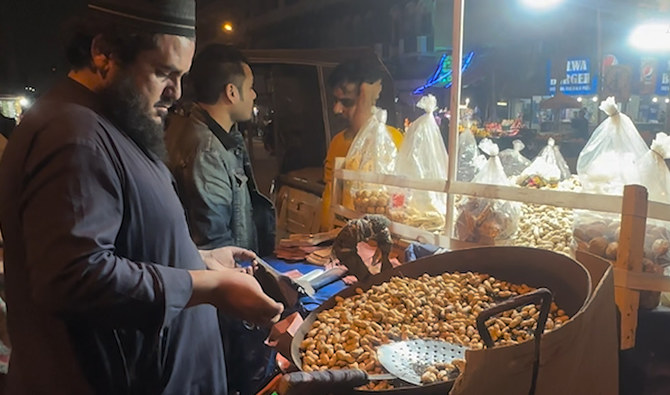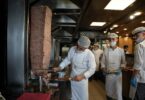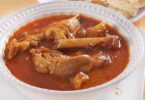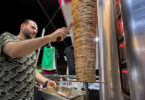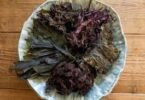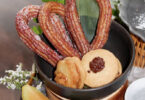Naimat Khan
KARACHI: A crowd had gathered around Noor Ali last week as he mixed peanuts with his sickle in a potful of burning hot sand, the aroma of the roasted nuts spreading all around his pushcart parked on one of the busiest roads in the southern Pakistani port city of Karachi.
There are other things like garbanzo beans and corn for sale but peanuts take center stage at Ali’s cart, marking the arrival in Karachi of cold Siberian winds from Quetta that usher in the city’s brief winter season each year. Indeed, you know winter has arrived in Karachi when peanut sellers like Ali appear on the streets and main roads, pushing their carts and selling nuts in paper cones recycled out of newspapers to everyone from school children to office workers.
“In the winter season, we come [from Quetta] and set up this pushcart,” Ali told Arab News on II Chundrigar Road, the city’s financial district. “This merchandise comes from Quetta [capital of Balochistan province], and so does the cold.”
Muhammad Yousuf Baloch, a customer standing next to Ali’s stall, agreed, saying Karachi’s winters weren’t “truly its own.”
“When cool winds from Quetta blow, these peanut sellers become more visible,” he said. “Its aroma, the aroma of its cooking, that entices the heart.”
Vendors like Ali sell peanuts from around midday to late into the night in the winter months.
“I come at 3 in the afternoon, then I stand until 3 or 4 at night,” the seller said.
Another vendor, Muhammad Naseem, said sales lasted around three months, starting in November, which is how long Karachi’s winter lasts, barely.
“Our work is associated with the cold, the colder the wind, the better our work goes,” he said at his pushcart parked in Karahi’s Saddar bazaar. “So, we eagerly await the wind from Quetta. When the Quetta wind blows, our work begins.”
When the winter season ends, many peanut vendors go back home to Balochistan, doing odd jobs for most of the year, and buying up peanut supplies. Others find low-paying jobs at workshops or roadside restaurants and stalls in Karachi while they wait for the next winter.
“During cold spells in Quetta, Karachi experiences a temperature drop attributed to Siberian winds (cold air mass) traversing Balochistan and reaching Karachi and the coastal belt,” weather expert Muhammad Riaz, a former DG of the MET office, explained.
In the summer months, intense sea winds result from low atmospheric pressure over land. In winter, however, the atmospheric pressure pattern reverses, leading to winter rainfall caused by weather systems from the west.
“When this weather system extends to the extreme south of Balochistan, it creates the opportunity for rain in Karachi and the surrounding area,” Riaz said. “Cold air masses (winds) originating from Afghanistan, Russia, and Central Asian states follow a route through Quetta and Balochistan to reach Karachi. Hence, there is a belief that Quetta influences the weather in Karachi.”
And as the weather cools down, Karachites look out for the famed peanut sellers from the southwest.
“Neither Karachi’s winter is its own, nor is Karachi’s peanut truly its own,” said Shahid Mustafa Khan, who has been a customer of Noor Ali’s for 25 years, and prefers peanuts over other nuts due to their low price.
A kilogram of peanuts costs between Rs1,000 ($3.5) and Rs1,400 ($4.9) in Karachi. The price varies in other parts of the country.
Customer Muhammad Ikram said the low price and warm peanuts was a winning combination.
“It’s cheaper here and expensive [when bought] from shops,” Ikram said, at Naseem’s cart in Karachi’s Saddar area. “They serve it warm on the spot.”

